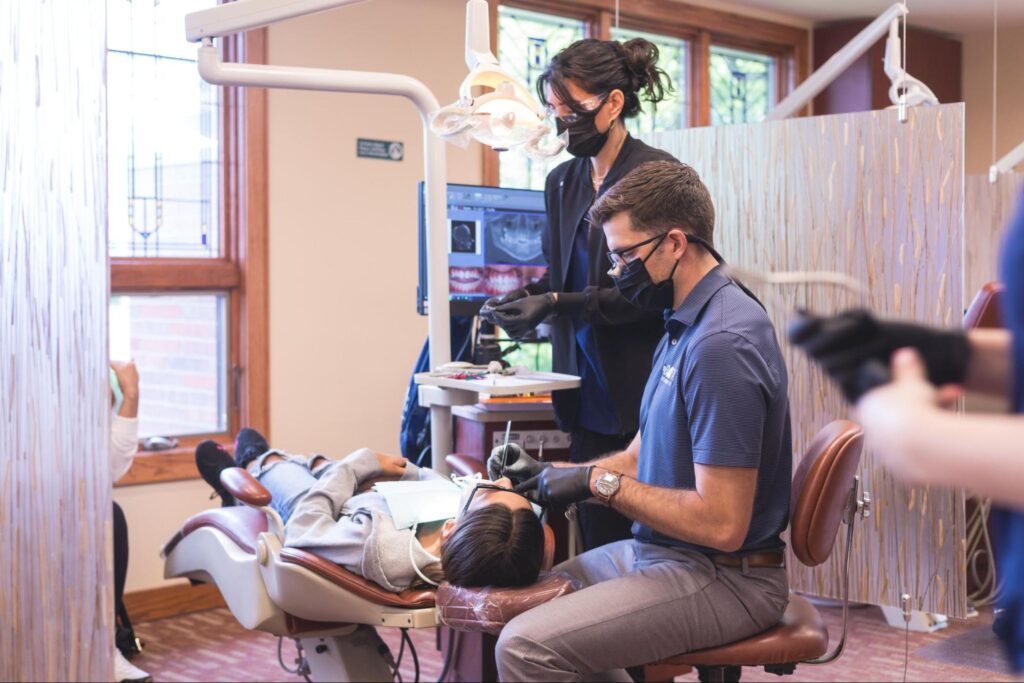Picture this: you’re enjoying a summer afternoon at Heritage Park in Homer Glen, snapping a quick photo with friends, but you hesitate to smile. Maybe you’ve been thinking about orthodontic treatment, but the biggest question on your mind is, “How long will it take?” Dr. Evan Booth and Dr. Ryan Booth at Booth Orthodontics hear this all the time, and the answer depends on a few important factors. Let’s break down what goes into the timeline and what to expect along the way.
What Determines How Long Orthodontic Treatment Takes?
No two orthodontic cases follow the exact same path, and the timeline depends on a variety of factors. Dr. Evan Booth and Dr. Ryan Booth at Booth Orthodontics evaluate each patient individually to determine the best approach. Here’s what plays the biggest role in determining how long it all takes:
Starting Point Matters
Minor spacing or slight crowding may take only a year, while complex cases that involve bite adjustments can take closer to two years or more.
Age Plays a Role
Younger patients typically experience faster tooth movement because their jawbones are still growing, but adults can still see fantastic results in a reasonable time frame.
Type of Treatment Chosen
Traditional braces, clear aligners, and other orthodontic appliances all work at different speeds based on how they apply pressure to teeth.
Consistency Is Key
Wearing clear aligners as instructed, keeping up with appointments, and following orthodontic recommendations can all help keep treatment on track.
With these factors in mind, let’s explore what the average timeline looks like for different treatment options.
How Long Does Each Type of Treatment Take?
Just like choosing between grabbing a bite at Pelican Harry’s or picking up something quick from Rubi Agave, different orthodontic treatments come with different time frames. Some work faster, while others focus on a gradual approach to long-term stability. Dr. Evan Booth and Dr. Ryan Booth at Booth Orthodontics help patients in Homer Glen find the best option for their needs. Here’s a general idea of how long different treatments take:
- Traditional Braces (Metal or Clear): The most common option, with treatment times typically ranging from 18 to 24 months, though some cases may be shorter or longer.
- Invisalign: These nearly invisible trays usually take between 12 to 18 months, depending on how consistently they’re worn.
- Limited or Short-Term Orthodontics: Some patients only need small adjustments, which can be completed in as little as 6 months.
- Two-Phase Treatment for Younger Patients: Early intervention treatments for kids can take 6 to 12 months in the first phase, with a second phase later to fine-tune results.
Every patient is different, but these timelines give a good starting point for what to expect. The next big question? Whether there’s a way to speed things up. Let’s take a look.

Can Treatment Be Sped Up?
Waiting for the perfect smile can feel like counting down to the HomerFest fireworks—exciting, but hard to be patient! While orthodontic treatment follows a natural process, there are ways to keep things moving efficiently. Dr. Evan Booth and Dr. Ryan Booth at Booth Orthodontics work with patients in Homer Glen to make sure treatment stays on track. Here’s how you can help speed things along:
- Stick to the Plan – Wearing clear aligners for the recommended hours or keeping up with elastic bands in braces makes a huge difference.
- Stay on Schedule – Regular appointments allow adjustments to be made at the right time, preventing unnecessary delays.
- Keep Teeth and Gums Healthy – Good oral hygiene helps teeth move more predictably, while cavities or gum inflammation can slow things down.
- Be Mindful of What You Eat – Hard, sticky foods can damage braces and extend treatment time due to necessary repairs.
While there’s no magic shortcut, following these steps can help you reach the finish line faster. Speaking of finishing treatment, let’s talk about what happens once the braces or aligners come off.
What Happens After Treatment?
Getting braces off or finishing your last set of clear aligners is a big moment. Dr. Evan Booth and Dr. Ryan Booth at Booth Orthodontics help patients keep their results in place long after treatment ends. Here’s what comes next:
Retainers Are a Must
Teeth naturally try to shift back over time, so wearing a retainer helps keep them in place.
How Long Do You Need a Retainer?
Most patients wear one full-time at first, then transition to nighttime wear indefinitely.
Different Retainer Options
Clear removable retainers, bonded retainers, or traditional wire retainers are all available based on your needs.
Follow-Up Appointments
Occasional check-ins at Booth Orthodontics allow Dr. Evan Booth and Dr. Ryan Booth to make sure everything is holding steady.
Finishing orthodontic treatment is an exciting milestone, but keeping that smile looking great is just as important. So, if you’ve been wondering when to start, let’s wrap things up with why there’s no better time than now.

The Best Time to Start? Right Now
Time passes by quickly, so why not spend it working toward a smile you’ll love for years to come? Dr. Evan Booth and Dr. Ryan Booth at Booth Orthodontics are here to make the process simple, with personalized treatment plans that fit your lifestyle. The first step is easy, no matter if you choose metal braces, clear braces, or clear aligners. Schedule your complimentary in-person or virtual consultation in Homer Glen and see just how close you are to the smile you want!
 Dr. Ryan Booth
Dr. Ryan Booth